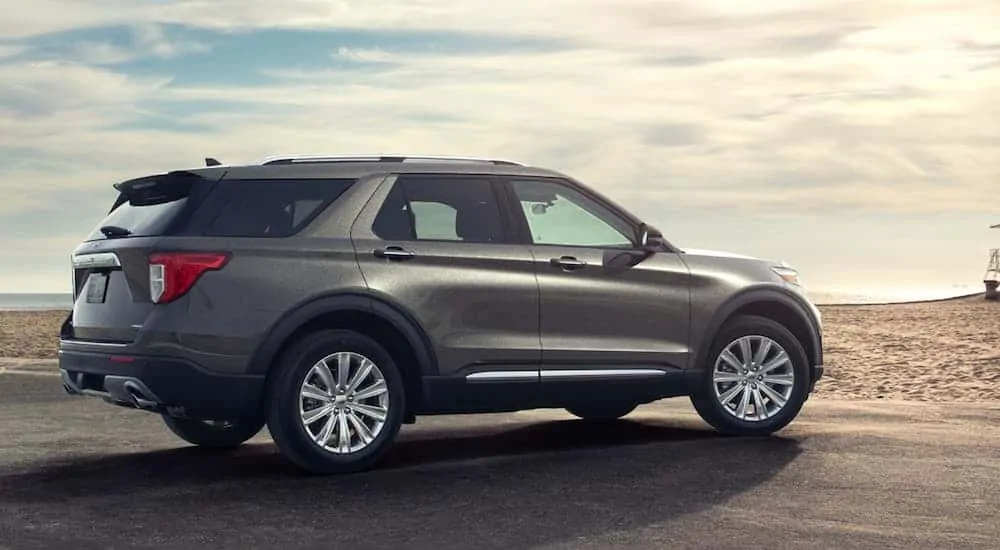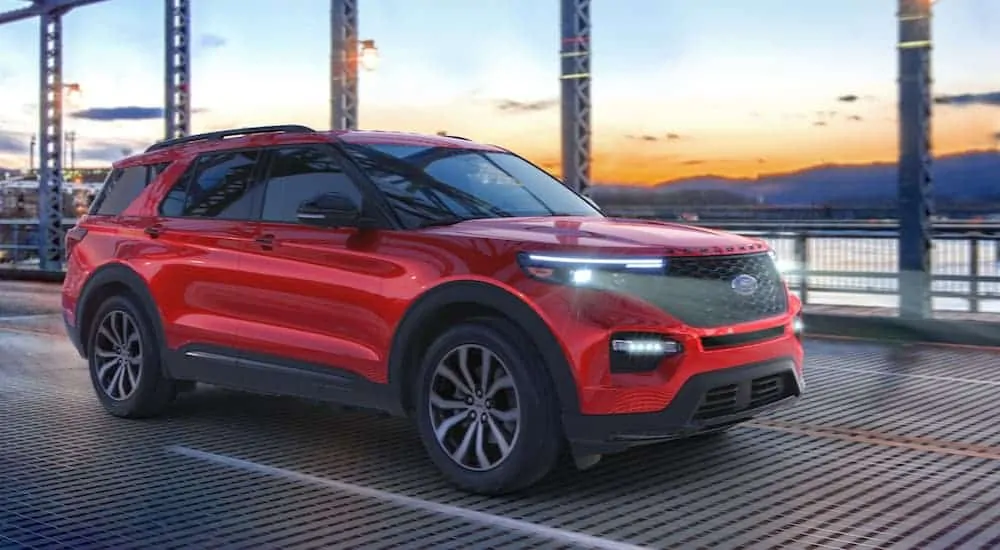The midsize SUV segment is one of the most competitive in the automobile world, so let’s take a look at two of the more popular 3-row SUVs out there: the 2020 Ford Explorer vs 2020 Honda Pilot. The Ford Explorer is one of the most popular SUVs ever, with total U.S. sales approaching 8 million, while the Honda Pilot is one of the many challengers vying for market relevancy in this competitive segment.
When choosing a midsize SUV, there are a lot of things to consider, since there are so many options now in the segment. So before we look into the details of these two SUVs, think about what you want from an SUV. Are you looking for as much cargo space as possible? Or maybe you’re looking for an SUV to tow your boat or camper. Or an SUV that has the most advanced safety features on the market. With so many options now in the segment, it seems there is an SUV out there for everyone.
This particular comparison is actually quite a showdown when you consider that the 2019 Honda Pilot won the Kelley Blue Book (KBB) award for Best Buy after a refresh for the 2019 model year. The Pilot, however, remains unchanged for the 2020 model year, while the Ford Explorer is all-new for the 2020 year with exciting changes to its chassis and overall design. So let’s see how these two SUVs compare now that they have both been recently updated.
Ford Explorer
One of the more notable changes for the 2020 model year is the Explorer’s new rear-wheel drive architecture. Previous models were based on the Taurus’ front-wheel drive chassis, but here we find the Explorer returning to its rear-drive roots to improve handling and towing without having to use a truck-like body-on-frame construction. This is a welcome change for the Explorer and one you will appreciate when you take the boat out to the lake.
Even with the changes, the new Explorer still looks like an Explorer, just different. It’s sportier and sleeker than previous generations. The front is bolder, and its profile is defined by oversized wheel arches and a roofline that angles toward the rear. It’s longer now too, with its wheelbase extended by 6.3 inches, which has improved its interior dimensions for all three rows of seats. The Explorer now has a slight edge over the Pilot in cargo space behind all three rows of seats.
While the Honda Pilot has one powertrain option, the Ford Explorer now has four choices. Standard on the Explorer is a 2.3-liter turbocharged inline-4 with 300 horsepower and 310 lb-ft of torque. This is an improvement of the previous model year’s engine, a 3.5-liter naturally aspirated V6, with more horsepower and torque. This engine strikes an impressive balance between power and fuel efficiency, getting 21/28 MPG (RWD), and 20/27 (AWD).

If you want more power or better fuel efficiency, Ford has other options for you. A 3.0-liter twin-turbo V6 engine with 365 horsepower and 380 lb-ft of torque is available in the Platinum trim. And if you’re looking for a sporty engine with lots of horsepower and torque, there’s a 3.0-liter twin-turbo V6 for the ST trim. This engine is nearly best in its class with 400 hp and 415 lb-ft of torque—only the Dodge Durango’s 6.4-liter V8 creates more power, but it gets only 13/19 MPG, while the Explorer’s big engine achieves 18/24 MPG, a significant edge.
The other engine option is where the Explorer truly separates itself from the Pilot. Now there is a Hybrid powertrain, and it doesn’t lack power. The 3.3-liter V6 electric motor gives 318 horsepower and 322 lb-ft of torque while getting 27/29 MPG (RWD) and 23/26 MPG (AWD). The estimated range is 500 miles for this engine.
With so many choices, the hard part will be deciding which engine is best for your needs. The Explorer seems to have more than caught up with the market with its redesign; it looks as though the Explorer is trying to reclaim its crown as best-selling midsize SUV.
Honda Pilot
Not to be discounted, the Honda Pilot is coming off a recent Best Value win for a reason. Known for its excellent resale value and reliability, the Honda Pilot is one of many formidable competitors in the midsize segment. The recent generation is also fun to drive, which makes it not just a practical SUV, but an SUV that makes sense for everyone now.
The 3.5-liter V6 engine and 6-speed automatic transmission put out 280 horsepower and 262 lb-ft of torque. A 9-speed transmission is offered for the higher trim levels. The 9-speed transmission improves fuel efficiency to the tune of 19/27 MPG (FWD) and 18/26 MPG (AWD). For only one option, this is a good one.
The Pilot’s pared-down approach takes the headache out of shopping. Even in the base-level LX trim, you can get everything you need from a family SUV. Standard are 18-inch aluminum wheels, and automatic LED headlights with automatic high-beams, 8-passenger seating, air conditioning, cruise control, power windows, a tilt/telescopic steering wheel, push-button engine starting, mirrors and locks, and a 5-inch display that includes Bluetooth hands-free calling and music streaming capability.
Honda is clearly committed to your family’s safety as it has made Honda Sensing standard for the Pilot as well. This is Honda’s suite of driver assists and collision-avoidance systems. Standard on the Pilot are safety features like adaptive cruise control, automatic emergency braking, lane-departure warning, forward-collision warning, lane-keeping assist, and a Road Departure Mitigation system that helps to prevent the Pilot from accidentally running off the road.
Which One Is Right for You?
So clearly, both SUVs are very competitive in their segment and are making this a tough choice. But how do you know which one is right for you? The Honda Pilot seems to have more safety features, but then the more you look at it, the more you see the Explorer has a host of standard safety features too. And both SUVs feature similar cargo space, so how do you decide?
Well, an obvious difference is in seating capacity as the Pilot seats 8, and the Explorer seats up to 7. So, if you need the extra seat, the Pilot makes more sense. But if you’re looking for more powertrain options, if you need to tow or are concerned about difficult driving conditions, the Explorer would be the better choice. Ford’s Terrain Management System helps with accelerator sensitivity, transmission shifting, steering effort, suspension firmness, traction-control programming, and all-wheel drive torque management. There’s even a setting for deep snow/sand to keep you going through the toughest of conditions. You’ll also find a setting called “trail.” This setting keeps you moving forward in muddy or uneven terrain. With the Pilot, you will not want to venture too far off the road, but its refresh did see an improvement in off-road capability with its i-VTM4 AWD system with mud and traction settings.
Coming into this showdown, it seemed to be a battle of the heart and mind: the Pilot as the practical choice and the Explorer as the choice your heart pulls toward. Though after comparing both redesigns, the Explorer just seems to be the better vehicle, regardless of how you look at it.





